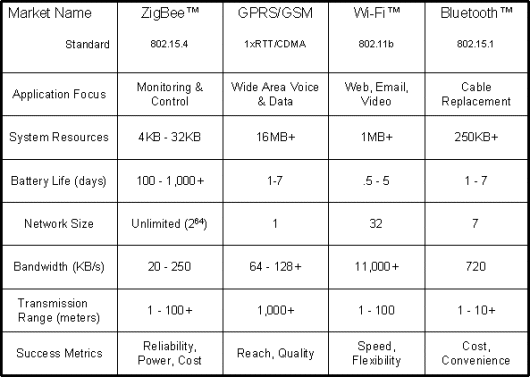Report: ZigBee — the next revolution in wireless technology
Sep 29, 2004 — by LinuxDevices Staff — from the LinuxDevices Archive — 47 viewsABI Research has released a report calling the ZigBee market a “sleeping giant,” and forecasting the deployment of 80 million ZigBee devices by the end of 2006. ZigBee is billed as a low-cost, low-power, low-data-rate wireless networking standard designed for monitoring and control applications in both industrial and home markets.
ZigBee was developed to serve different applications than Bluetooth and its technology leads to “tremendous optimizations in power consumption,” according to the ZigBee Alliance, a trade association formed to promote the standard. According to the organization, some key differentiators from Bluetooth include:
- Very low duty cycle, very long primary battery life
- Static and dynamic star and mesh networks, 65,000+ nodes, with low latency available
- Ability to remain quiescent for long periods without communications
- Direct Sequence Spread Spectrum allows devices to sleep without the requirement for close synchronization
Potential ZigBee applications include home automation, wireless sensors, interactive toys, smart badges and remote controls.

Comparison of ZigBee with other wireless standards
(Source: ZigBee Alliance; note: “KB/sec” refers to kilobits/sec)
While ZigBee is applicable in both industrial and consumer markets, ABI's report suggests that the consumer sector will provide “many times the revenue of the most optimistic predictions for industry,” in a mature ZigBee market. And while industrial buyers will get the ZigBee ball rolling, ultimately the consumer sector will be easier for vendors to enter because technical requirements there are less stringent.
Yet, according to ABI Research analyst Chris Lopez, many ZigBee companies seem reluctant to enter the consumer arena. “Some are waiting for ratification of the ZigBee standard and for the ZigBee home market to develop,” he says, “while a few others are plunging ahead, hoping to win consumers' trust early in the game.”
A ZigBee node consists of a combination of hardware and software. Many companies, says Lopez, “want to deal with the software, but not with the consumer electronics. But if you want to do anything with ZigBee right now you must do both, because there are no products yet.”
Lopez contends that ZigBee is going to be “the next revolution in wireless technology.” 2006 is not that far off, he notes, and companies wanting to stake a claim should begin laying their consumer-side strategies now, not later.
More information on the ABI report, ZigBee and 802.15.4 Wireless Networks, is available here.
This article was originally published on LinuxDevices.com and has been donated to the open source community by QuinStreet Inc. Please visit LinuxToday.com for up-to-date news and articles about Linux and open source.